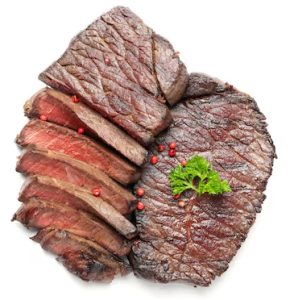We acquired ten purebred heifers in the fall of 2007 and then purchased our first herd sire in the late spring of 2008, with our first calf born in 2009. Thus, the beginnings of our highland fold (a herd of Scottish Highland Cattle is called a fold).
The Scottish Highland Cattle have proven to be everything that is written and said about them. Our research into the history and characteristics of the breed indicated that they would be a good match to the type of farm we had to work with, the landscape, the weather, and our plans for integrating biodynamic agricultural practices.
They quickly came together and formed a very strong bond as a herd. As much as they have their herd hierarchy, they look out for each other and not one is ever left behind. Our property is adjacent to 3,000 acres of conservation land with everything from coyotes, wolves, bears, fox, deer, weasels, skunks, porcupines and stray dogs wondering through. They wonder free with little incidence of predators.
Having purchased property that was not worked for well over six years, cattle have served to push back the intrusion of the forests into the fields, which in some areas has been as much as fifteen feet. The two wooded pastures which were almost completely impassible due to scrub growth have been restored to a state whereby sunshine and rain are able to penetrate the foliage growth and grasses have returned thus providing natural forage for the animals. The canopy has been naturally pruned by the cattle and there is a relationship between the two. The wooded pasture area is actually one of their most favorite places to be.
The herd has shown themselves to be hardy foragers at best, with pallets not only for grasses, clover and alfalfa, but they munch down on prickly ash, apple, golden rod, thistle, wild parsnip, sumac, and wide variety of wild plants.
Just as the experts on the breed mention, they do use their horns just like we would use our fingers. They are well aware of how to use and manipulate their horns, both gently and at times effectively. The rare moment of aggression within the herd is usually a brief head bashing, following by one backing off in submission.
Our barn is old with little shelter from the cold or protection from predators. Again, a reason why we chose this breed. In minus thirty degree winter conditions they stand outside in the blustery winter weather huddled together like husky dogs in the arctic north. Their thick shaggy coats and hair over their eyes are definitely an asset, especially in our northern climate.
They are easy-going in nature, exceptionally easy to move and manage from one pasture to another, and naturally prefer pasture greens to grains, sweet feeds, and treats. Our herd is moved from one pasture area to another on a regular rotation, with access to water and natural shade in all areas. They have to walk to and from the barn for water and thus get ample exercise.
The meat is muscular with little fat. The taste is sweet and extremely nutritious. We have been able to reduce our meat consumption more than half in all recipes and feel full, satisfied and energized. Our personal experience tells us that the meat is everything that it should be and more.
We believe that our herd are happy, content and are being raised in an environment that allows them to be what they came into this world to be, and are able to be the best that they can be.
Scottish Highland Cattle Meat is Premium Beef
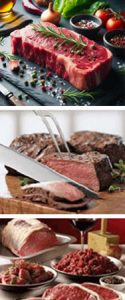 The Scottish Highlander has a modern beef carcass with lean, well-marbled, flesh that ensures tenderness and succulence with a very distinctive flavor. Highland beef is healthy and nutritious with lower levels of fat and cholesterol and a higher protein and iron content than other beef.
The Scottish Highlander has a modern beef carcass with lean, well-marbled, flesh that ensures tenderness and succulence with a very distinctive flavor. Highland beef is healthy and nutritious with lower levels of fat and cholesterol and a higher protein and iron content than other beef.
The Scottish Highlander's proven ability to produce top quality meat without the addition of expensive high quality feeds makes this breed the perfect choice for those people who wish to produce beef with natural inputs.
Scottish Highland beef is slow-maturing making it a premium beef which is lean, well marbled with low fat and cholesterol levels whilst remaining rich in protein and flavor, criteria increasingly demanded by today's market.
If highlanders have access to forested pastures, they will forage and the meat will have a more wild taste that can be similar to venison.
A heavy coat insulates against a harsh climate and reduces the need to develop excess back fat.
Recent studies in both North America and the UK have shown that Highland Beef is consistently much lower in fat content and cholesterol than other breeds. It is so lean that it compares with chicken and fish fat content.
The marbling of the beef gives the same tenderness and tastiness as the other larger breeds.
Studies in the US have verified that Highland Beef is 38% lower in fat content and 4% lower in cholesterol than steaks from local supermarkets.
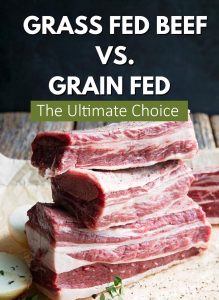 According to Dr. Axe, dietitians and other health professionals the following are some of the health benefits of eating grass-fed beef.
According to Dr. Axe, dietitians and other health professionals the following are some of the health benefits of eating grass-fed beef.
- Reduces the Risk of Heart Disease — the main reasons why grass-fed beef can benefit heart health include less overall fat and unhealthy fat, lower levels of cholesterol, high levels of omega-3, more CLA and disease fighting vitamins.
- Improves Blood Sugar — getting enough healthy fat in your diet is extremely helpful to keeping your blood sugar at a healthy level.
- Potential Cancer Fighter — the CLA has proven its ability to fight cancer in multiple animal studies and shows promise for doing the same in humans.
- More Likely to be Free of Hormones & Antibiotics — grass-fed beef raised naturally in an organic environment should be free of hormones & antibiotics.
Note: conjugated linoleic acid (CLA) is a beneficial fatty acid found naturally in beef and dairy products.
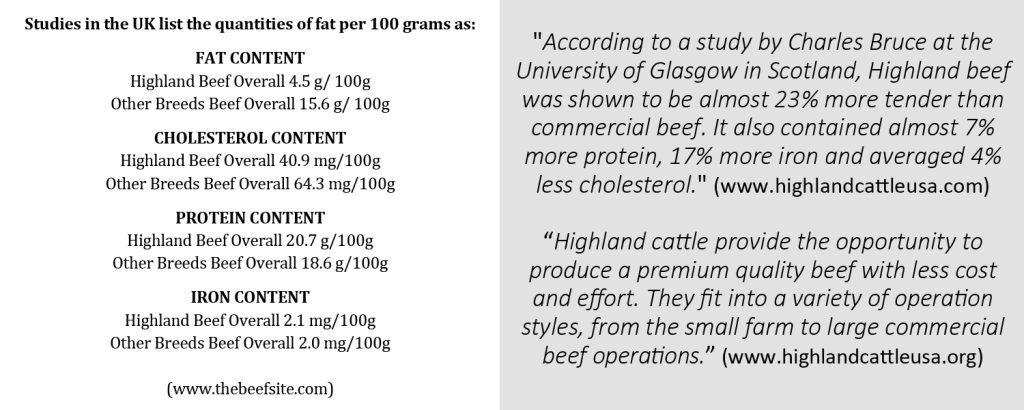
100% Grass-Fed Beef & Grass-Finished from Scottish Highland Cattle!
According to the Mayo-Clinic and many other authorities, grass-fed and grass-finished beef is becoming a highly sought after commodity for the following health reasons.
We have many people coming up our lane-way looking for grass-fed, grass-finished beef on the advise of their health care practitioners and dietitians.
- Less total fat.
- More heart-healthy omega-3 fatty acids.
- More conjugated linoleic acid, a type of fat that's thought to reduce heart disease and cancer risks.
- More antioxidant vitamins, such as vitamin E.
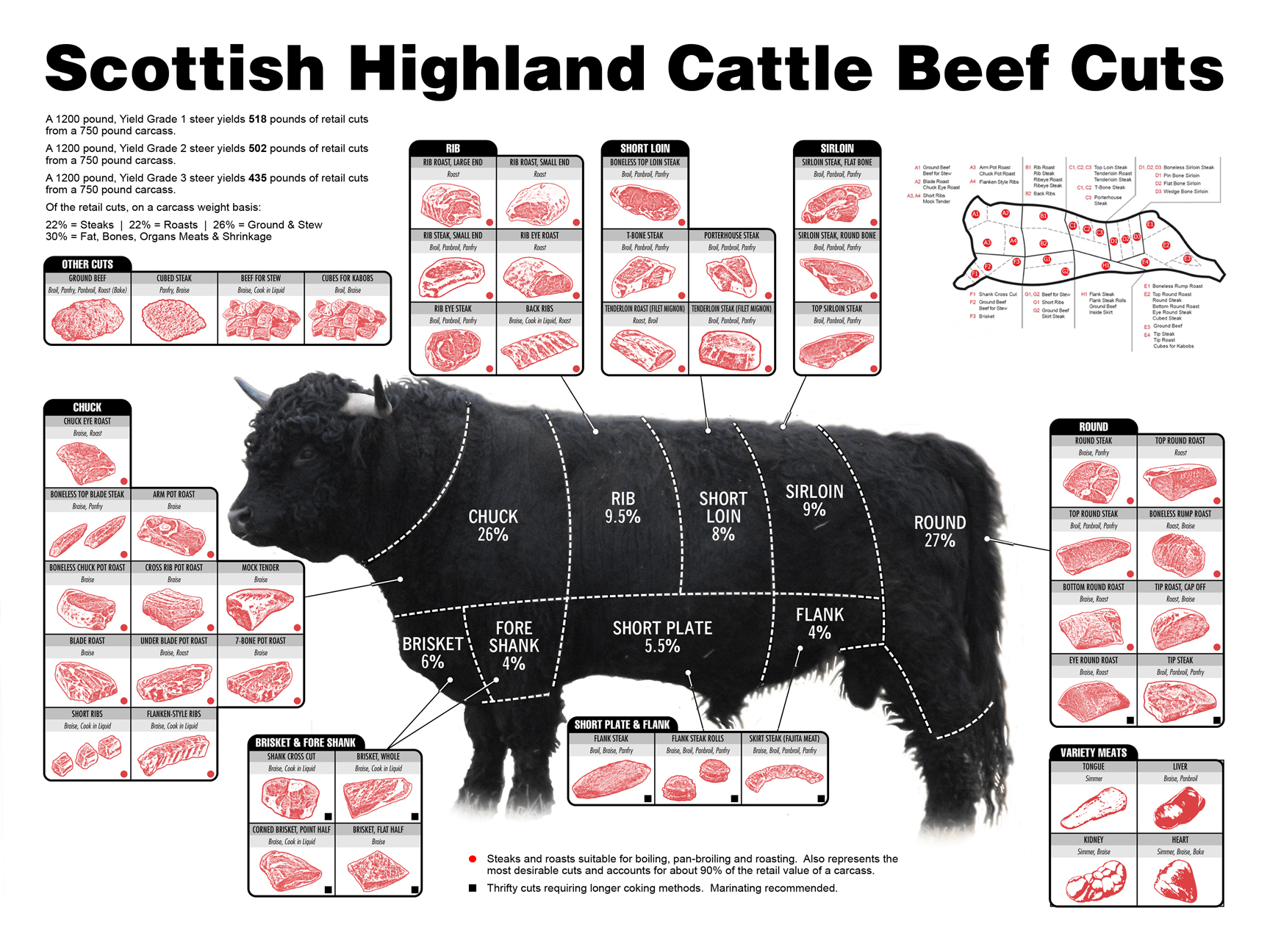
Order your own copy of this 18" x 24" poster, featuring Earth Haven Farm's purebred, Clachan Glas Rainier, black bull.
Contact us for details.
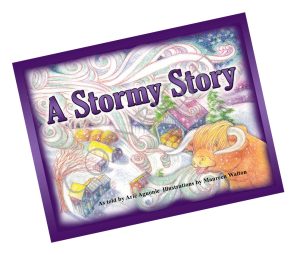 A True Story from the Farm
A True Story from the Farm
Aric Aguonie has published a wonderful children's story book which is based on a true event that happened here at Earth Haven Farm one winter day, between him and one of his Scottish Highland Cows.
This 32 page storybook has been beautifully illustrated by the talented mural artist, Maureen Walton from Marysville, Ontario. www.maureenwalton.com
To obtain a copy of this book and Contact Us or visit Aric at Evergreen Brickworks farmers market or stop by the farm.

